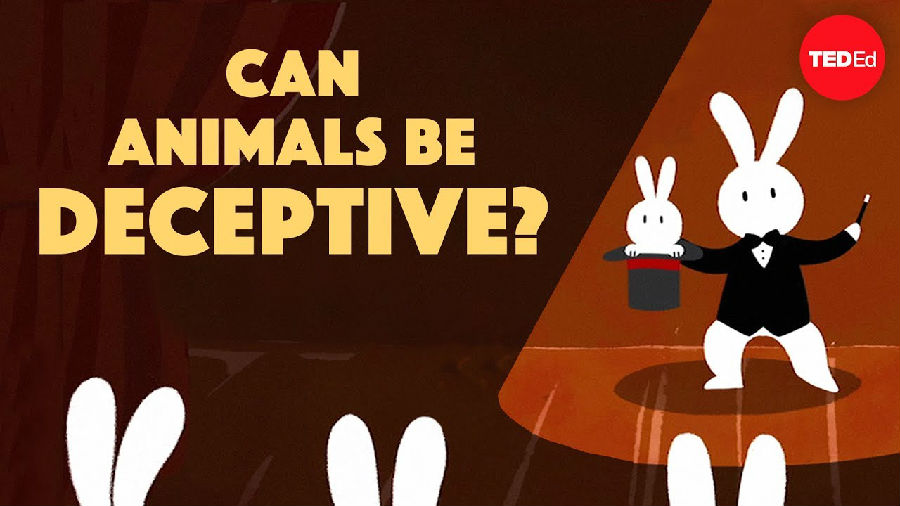(单词翻译:单击)
A male firefly glows above a field on a summer's night, emitting a series of enticing flashes.
夏夜,一只雄性萤火虫在田野上闪闪发光,释放着一串求偶的灯光信号。
He hopes a nearby female will respond with her own lightshow and mate with him.
他盼望附近的异性会用她的灯光秀来回应,并且和他交配。
Sadly for this male, it won't turn out quite the way he plans.
可悲的是,计划赶不上变化。
A female from a different species mimics his pulsing patterns:
另一雌性物种正模仿着他的灯光频率:
by tricking the male with her promise of partnership, she lures him in -- and turns him into an easy meal. He's been deceived.
用虚假的爱情承诺将他引诱到自己身边,并轻易将他化为盘中之餐。他被耍了。
Behavioral biologists have identified three defining hallmarks of deception by non-human animals:
行为生物学家们已经确定了动物欺骗术的三个特征:
it must mislead the receiver, the deceiver must benefit, and it can't simply be an accident.
误导受骗者,施计者得利,欺骗行为并非偶然产生。
In this case we know that the predatory firefly's signal isn't an accident
在上述情境中,我们可以确定雌性捕食者的信号不是偶然产生的,
because she flexibly adjusts her flash pattern to match males of different species.
因为她灵活地调整着灯光信号以和其它雄性物种的信号对应。
Based on this definition, where is animal deception seen in nature?
基于以上定义,自然界中有哪些动物欺骗现象呢?
Camouflage is a good starting point -- and one of the most familiar examples of animal trickery.
不妨从天然保护色说起,这是最为熟知的动物骗术之一。
The leaf-tailed gecko and the octopus fool viewers by blending into the surfaces on which they rest.
枯叶平尾壁虎和章鱼通过与其栖息的环境融合骗过其他生物。
Other animals use mimicry to protect themselves.
其它动物通过模仿进行自我保护。
Harmless scarlet kingsnakes have evolved red, yellow, and black patterns
无毒的猩红王蛇进化出了红、黄、黑色的图案,
resembling those of the venomous eastern coral snake to benefit from the protective warnings these markings convey.
和剧毒的珊瑚蛇极为相似,这便占了这些保护性恐吓图案的便宜。
Even some plants use mimicry: there are orchids that look and smell like female wasps to attract hapless males, who end up pollinating the plant.
更有甚者,一些植物也会进行模仿:有些兰花在外观和气味上与雌性黄蜂相似,以此吸引不幸的雄性黄蜂为它们授粉。
Some of these animals benefit by having fixed characteristics that are evolutionary suited to their environments.
有些动物从其固有的特征上获益,这些都是长期进化、适应环境的结果。
But in other cases, the deceiver seems to anticipate the reactions of other animals and to adjust its behavior accordingly.
但在其它情况下,行骗者似乎能预料到其他动物的特定行为,并据此相应地调整自身行为。
Sensing a threat, the octopus will rapidly change its colors to match its surroundings.
当察觉到危险时,章鱼会迅速变为与周围环境相似的颜色。
Dwarf chameleons color-match their environments more closely when they see a bird predator rather than a snake
在发现鸟类捕食者时,侏儒变色龙的颜色会变得与环境极其相似,遇见蛇时颜色却未如此相近,
birds, after all, have better color vision.
毕竟鸟类对颜色更加敏感。

One of the more fascinating examples of animal deception comes from the fork-tailed drongo.
动物诈骗者中最耀眼的明星当属叉尾乌鹃。
This bird sits atop tall trees in the Kalahari Desert, surveying the landscape for predators and calling when it senses a threat.
这种鸟栖于卡拉哈里沙漠的高大树木之顶,视察领地,关注捕食者的身影,并在察觉危险时发出警报。
That sends meerkats, pied babblers, and others dashing for cover.
警报声使非洲獴、斑鸫鹛和其它动物四处逃窜。
But the drongo will also sound a false alarm when those other species have captured prey.
但当其它物种的动物捕获了猎物时,乌鹃也会发出假警报。
As the meerkats and babblers flee, the drongo swoops down to steal their catches.
当非洲獴和斑鸫鹛逃离时,乌鹃飞旋而下,偷走它们的战利品。
This tactic works about half the time -- and it provides drongos with much of their food.
这种战术有一半的成功几率,是卷尾鸟重要的食物来源。
There are fewer solid cases of animals using signals to trick members of their own species, but that happens too.
动物很少利用信号欺骗同类物种,但这也会发生。
Consider the mantis shrimp. Like other crustaceans, it molts as it grows, which leaves its soft body vulnerable to attack.
比如说螳螂虾。和其它甲壳动物一样,它在生长过程中也会蜕壳,蜕壳后身体柔弱,易受攻击。
But it's still driven to protect its home against rivals. So it has become a masterful bluffer.
但它还是无法推卸保家抗敌的重任。环境将它塑造成了老谋深算的江湖骗子。
Despite being fragile, a newly molted shrimp is actually more likely to threaten intruders,
虽然身体不堪一击,刚蜕壳的螳螂虾更爱吓退对手,
spreading the large limbs it usually uses to strike or stab its opponents.
通过伸展开通常用于击打对手的粗大肢节。
And that works -- bluffers are more likely to keep their homes than non-bluffers.
这还真有有效,这些骗术大师们比正常的螳螂虾更可能守住自己的洞穴。
In its softened condition, a mantis shrimp couldn't withstand a fight -- which is why we can be confident that its behavior is a bluff.
在身体柔弱的条件下,螳螂虾没有能力干上一架,这也是我们能够确定此类行为是骗术的原因。
Biologists have even noticed that its bluffs are tactical:
生物学家们发现,如此虚张声势也是有针对性的:
newly molted mantis shrimp are more likely to bluff against smaller rivals, who are especially likely to be driven away.
刚蜕壳的螳螂虾更倾向于吓唬体型较小的对手,这类对手容易被吓退。
It would seem that instead of just threatening reflexively,
与其说是本能地虚张声势,
the mantis shrimp is swiftly gauging the situation and predicting others' behavior, to get the best result.
不如说螳螂虾是在快速地掂量所处现状和预测对方的行为,以取得最优结果。
So we know that animals can deceive, but do they do so with intent?
所以我们明白地知道动物们会欺骗,但它们是在有意识地欺骗吗?
That's a difficult question, and many scientists think we'll never be able to answer it.
很难回答,很多科学家认为我们永远无法揭开这个谜底。
We can't observe animals' internal thoughts.
我们无法窥见动物的思维。
But we don't need to know what an animal is thinking in order to detect deception.
但无需通过知晓动物的思维来辨别欺骗行为存在与否。
By watching behavior and its outcomes, we learn that animals manipulate predators, prey, and rivals,
通过观察它们的行为及其结果,我们发现动物能够操纵捕食者、猎物和对手,
and that their capacity for deception can be surprisingly complex.
而且,骗术的复杂程度超乎我们的想象。


